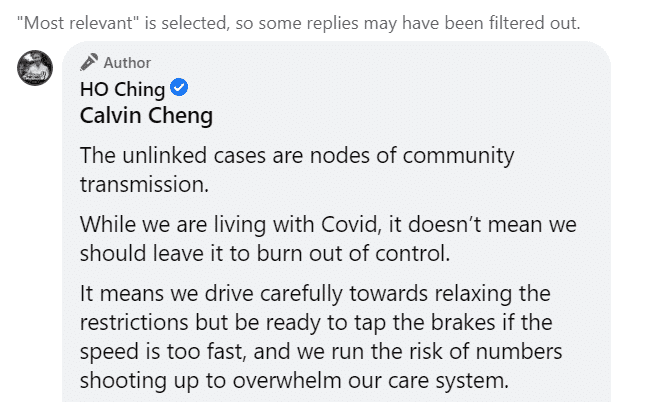According to statistics fabricated by Goody Feed, an argument on Facebook takes place every four seconds.
Typically, it’s our uncle squabbling with another uncle, but more recently, a very public spat was observed between two prominent figures.
And unsurprisingly, the topic of contention was COVID-19.
Ho Ching Opposes New MOH Report Format
As you know, the Ministry of Health (MOH) has revamped its daily report, with its new report omitting the number of linked and unlinked cases.
One of the many netizens who disagreed with this move was Temasek Holdings CEO Ho Ching, who argued that the change came too soon.
“We are not there yet, and unlinked cases are still relevant for the purpose of getting a sense whether we are having a runaway gallop or a steady trot,” she said in a post on Facebook.
“We should still provide daily case breakdown between linked and unlinked, and between quarantined linked and unquarantined linked.”
She said that this will give us an idea of the number of potential cases that could crop up in the future, and whether our contract tracing efforts are sufficient.

She believes that these numbers should continue to be released until the end of the year.
Former NMP Disagrees, Debate Ensues
One notable commenter who disagreed with Ho’s stance was Calvin Cheng, a former Nominated Member of Parliament.
Cheng believes that the only practical use for linking cases is to inform close contacts to self-isolate.
“The total number of unlinked cases tells us nothing if we are no longer pursuing a Covid-zero policy,” he wrote.
“In the past, we counted linked cases in order to stub out every case. Therefore the number of unlinked cases tells us how successful we were in doing this.”
However, since we’re pursuing an endemic policy, he noted, the number of unlinked cases wouldn’t be of much use.

Like most Facebook debates, a response to a post isn’t enough. A response to the response to the response usually follows. And this particular discussion was no different.
In response to Cheng’s comment, Ho pointed out that while we have chosen to live with the virus, it doesn’t mean we should “leave it to burn out of control.”
“It means we drive carefully towards relaxing the restrictions but be ready to tap the brakes if the speed is too fast, and we run the risk of numbers shooting up to overwhelm our care system,” she wrote.
Using an example, she argued that having access to the number of linked and unlinked cases would allow us to determine the speed at which new cases are popping up.

Cheng replied saying that the R number is more useful, referring to the rate at which a virus spreads.
“As cases rise, the number of contact tracers needed will also rise. Is it sensible to deploy funds on an army of contact tracers, following every case down a rabbit hole?” Cheng asked.
He added that if we do chase down every linked case and place them under quarantine, scores of people would have to be isolated.
“This would be extremely disruptive to daily life. And certainly not what living with the virus looks like,” he wrote.
In response, Ho clarified that it’s not the number of unlinked cases that is important per se, but how many people were infectious in the community before they were picked up and quarantined.
The debate raged on for a few comments, and netizens threw their own opinions into the mix as well.
What Do the Experts Think?
The experts seem to agree with Cheng, as they too believe there’s no need to differentiate between linked and unlinked cases if we’re treating COVID-19 as endemic.
Professor Paul Tambyah, an infectious disease expert, pointed out that we don’t track such numbers for other endemic diseases.
What’s more, as another expert noted, these numbers have even less relevance with our high vaccination rate, since fully vaccinated individuals are far less likely to fall severely ill from the disease.
Instead, a useful statistic would be the number of cases requiring hospitalisation, supplementary oxygen, or intensive care.
This not only provides an indicator of the severity of an outbreak, but can also help prevent our healthcare system from being overwhelmed.
In its new report, MOH will continue to list the number of severely ill patients, locally transmitted cases, as well as the number of large, emerging clusters.
Read Also:
- IKEA’s New Grab & Go Swedish Bistro Offers Gourmet Hotdogs and Blueberry & Banana Ice Cream
- Over 79,400 Data of MyRepublic Customers Stolen by Hacker
Featured Image: Facebook (HO Ching; Calvin Cheng)




